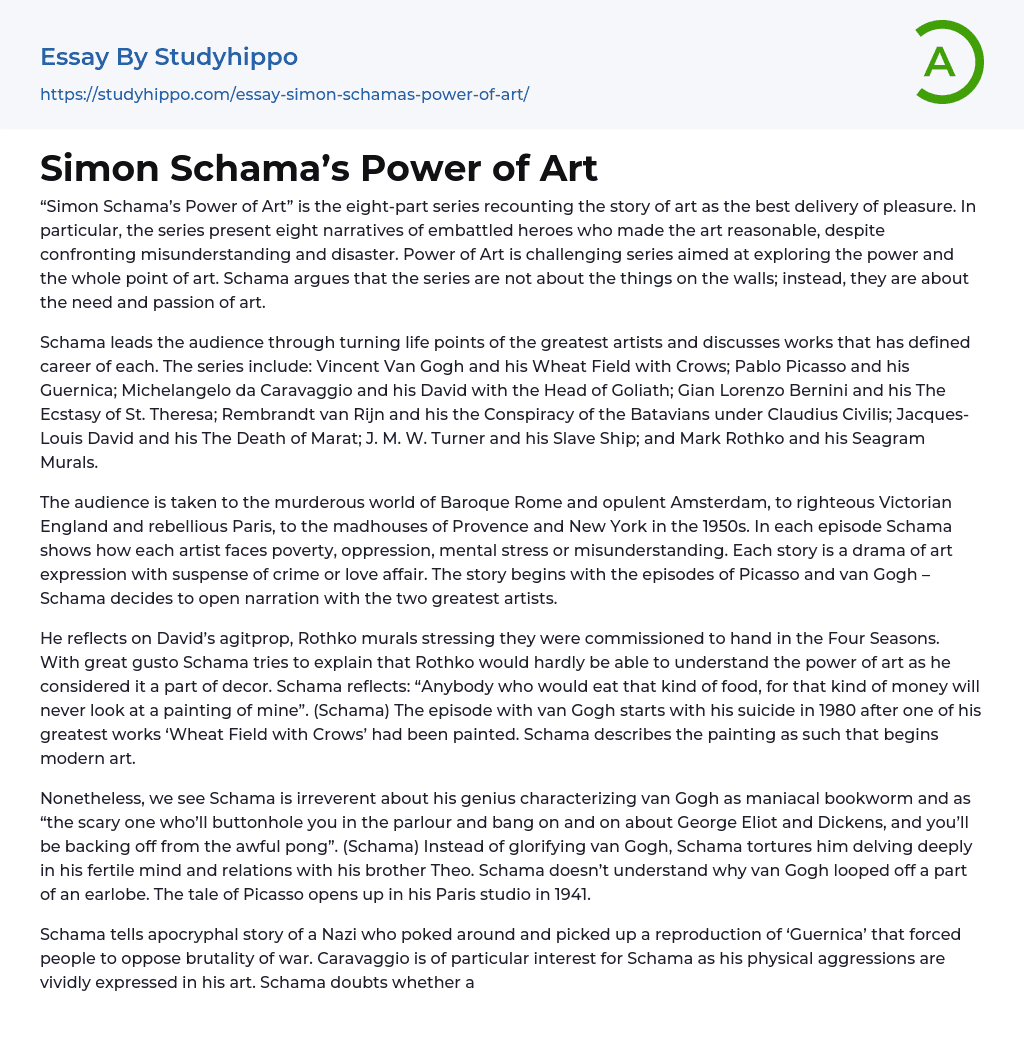“Simon Schama’s Power of Art” is the eight-part series recounting the story of art as the best delivery of pleasure. In particular, the series present eight narratives of embattled heroes who made the art reasonable, despite confronting misunderstanding and disaster. Power of Art is challenging series aimed at exploring the power and the whole point of art. Schama argues that the series are not about the things on the walls; instead, they are about the need and passion of art.
Schama leads the audience through turning life points of the greatest artists and discusses works that has defined career of each. The series include: Vincent Van Gogh and his Wheat Field with Crows; Pablo Picasso and his Guernica; Michelangelo da Caravaggio and his David with the Head of Goliath; Gian Lorenzo Bernini and his The E
...cstasy of St. Theresa; Rembrandt van Rijn and his the Conspiracy of the Batavians under Claudius Civilis; Jacques-Louis David and his The Death of Marat; J. M. W. Turner and his Slave Ship; and Mark Rothko and his Seagram Murals.
The audience is taken to the murderous world of Baroque Rome and opulent Amsterdam, to righteous Victorian England and rebellious Paris, to the madhouses of Provence and New York in the 1950s. In each episode Schama shows how each artist faces poverty, oppression, mental stress or misunderstanding. Each story is a drama of art expression with suspense of crime or love affair. The story begins with the episodes of Picasso and van Gogh – Schama decides to open narration with the two greatest artists.
He reflects on David’s agitprop, Rothko murals stressing they were commissione
to hand in the Four Seasons. With great gusto Schama tries to explain that Rothko would hardly be able to understand the power of art as he considered it a part of decor. Schama reflects: “Anybody who would eat that kind of food, for that kind of money will never look at a painting of mine”. (Schama) The episode with van Gogh starts with his suicide in 1980 after one of his greatest works ‘Wheat Field with Crows’ had been painted. Schama describes the painting as such that begins modern art.
Nonetheless, we see Schama is irreverent about his genius characterizing van Gogh as maniacal bookworm and as “the scary one who’ll buttonhole you in the parlour and bang on and on about George Eliot and Dickens, and you’ll be backing off from the awful pong”. (Schama) Instead of glorifying van Gogh, Schama tortures him delving deeply in his fertile mind and relations with his brother Theo. Schama doesn’t understand why van Gogh looped off a part of an earlobe. The tale of Picasso opens up in his Paris studio in 1941.
Schama tells apocryphal story of a Nazi who poked around and picked up a reproduction of ‘Guernica’ that forced people to oppose brutality of war. Caravaggio is of particular interest for Schama as his physical aggressions are vividly expressed in his art. Schama doubts whether a mentally stable person would present such shocking self-portrait, on which Caravaggio’s face is presented in the severed Goliath’s head. When talking about Bernini, Schama stresses that, when the artist needs a miracle for salvaging his genius reputation, he simply sculpts one.
In Turner’s masterworks
Schama reveals humanity’s creative spark and stresses the possibility of rekindled future. He exclaims: “My Turner, extreme Turner, the cockney poet just short of madness. The Turner we ought to know. The Turner we really ought to revere”. (Schama) ‘The Death of Marat’ by Jacques-Louis David re-assesses the image of political propaganda. Schama concludes that art has a power that can’t be defused even by a superpower. In his series Schama imagines the studios, visits the churches and walks famous streets.
The audience is presented with the blend of the great paintings, mental instability, and blood on the floor. The series reflect on the pivotal moments in life of eight artists who had to confront oppression and misunderstanding to express their emotions and anxieties in their masterpieces. Schama questions whether art has the power to triumph over commerce and fight atrocity. The series are the collision between the power of art and indifferent world. Art is the flood of truth, flight of freedom so desired by the greatest artists.




